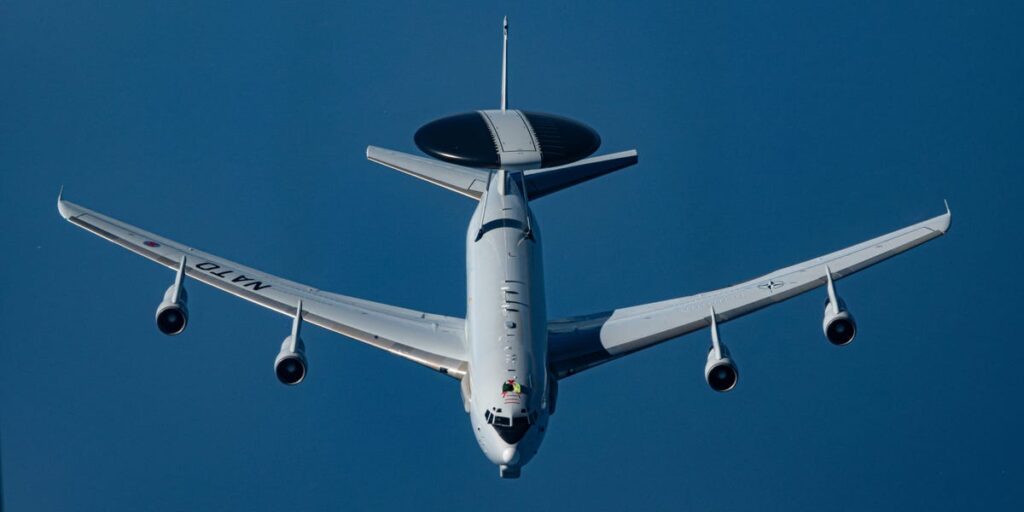NATO AIR BASE GEILENKIRCHEN — Stepping aboard the E-3 Sentry feels a bit like walking into a museum. The modified Boeing 707/320 passenger jet is decades old, and the dated interior is a constant reminder.
But don’t let the jet’s age fool you. The E-3, an Airborne Warning and Control System, or AWACS, is packed with highly advanced technology that enables it to perform surveillance, communications tasks, and battlefield command and control.
“It’s an aging aircraft, but it’s still relevant,” Capt. Jasper, a Dutch surveillance controller who monitors air and surface activity, explained. Over the past couple of decades, he said, whenever there was a conflict, “the NATO AWACS was always the first one to deploy.” In the early days of the Ukraine war, these aircraft were just about flying around the clock.
Business Insider recently flew aboard a NATO AWACS from Geilenkirchen, in western Germany, to the Baltic region and back. The eight-hour surveillance mission was tasked to support an alliance security operation in the Baltic Sea following the sabotage of critical undersea infrastructure.
The modified E-3 began engineering, testing, and evaluation in 1975, and two years later, the first operational aircraft was delivered to the US Air Force. NATO received its first of 17 E-3s in early 1982; 14 planes are operating out of Geilenkirchen Air Base.
During its more than 40 years in service, the Sentry has flown to support missions and conflict operations around the world, including over North America, Europe, and the Middle East. More recently, the NATO alliance has increased its focus on Eastern Europe and monitoring of Russian activity following Moscow’s invasion of Ukraine.
For a “very old aircraft,” it is “still very relevant nowadays,” said Capt. Jasper, who, like other members of the multinational crew that BI spoke with during the flight, could only be identified by his rank and first name for security reasons.
Every year ‘will be more challenging’
While the interior of the E-3 gives off Cold War relic vibes, the aircraft is a highly sophisticated flying radar and airborne command post packed with sensitive technology and computer monitors displaying a range of highly classified information that was sanitized thoroughly before BI was allowed to take a look.
The aircraft is equipped with a large 360-degree rotating radar dome, which can see over 300 miles across the air and surface, and advanced sensors that can detect friendly or hostile objects from far away.
Data collected by the E-3 can then be distributed in real time to allied aircraft, ships, or ground stations, giving battlefield commanders essential situational awareness in war or peacetime. And unlike fixed land-based radars, the aircraft is not restricted by terrain or the curvature of the Earth.
“We have a unique capability,” Capt. Jasper explained. “We can fly, we can see a little bit further, we can see a little bit lower, and we can take maritime assets as well.”
The E-3 is a flexible command and control platform capable of battle management; it can coordinate with other aircraft — fighter jets, bombers, or tankers — whether during a conflict sortie or just during a training run.
Maj. Ben, an American officer and the AWACS’ fighter allocator in charge of coordinating with other aircraft, described the E-3 as a “critical C2 (command and control) node,” explaining that “it provides that long reach of a radar for our higher headquarters, as well as communications.”
“We have the radar, we have the radios, to be able to reach out at long ranges and communicate, coordinate, and control any aircraft that we can see, and then we can talk to,” he said. “We’re also able to reach back to higher headquarters and pass along any critical information so they can make better decisions” with that real-time data.
The E-3 doesn’t necessarily look any different than it did back in the 1980s, but even though the airframe remains the same, the systems have continuously been updated over the years, explained Dutch Capt. Donny Demmers, a public affairs officer who was permitted to share his full name.
A recent $1 billion final modernization effort, for instance, is intended to provide the AWACS with new communications and networking capabilities, according to a NATO fact sheet.
The E-3’s system upgrades over the years have been so significant that Capt. Jasper, who previously flew with the plane from 2010 to 2015, needed to renew his training when he returned in 2022. There had been so many changes.
However, as time goes on, Demmers said the logistics of maintaining the aircraft have become increasingly challenging, especially because production lines are not cranking out readily available spare parts, like the engines.
“It’s still safe, but every year we pass, it will be more challenging” to keep the aircraft up to standard, he said.
NATO announced plans in 2023 to eventually replace the E-3 fleet with Boeing’s E-7 Wedgetail, a derivative of the US aerospace giant’s next-generation 737 aircraft. The first new aircraft is expected to be ready for operational duty by the early 2030s, with the E-3s set to retire after 2035.
But until that day comes, the E-3 crew is more than happy with its performance and believes that the mission will continue on uninterrupted.
“It’s still a good jet and we are performing our task. We are fulfilling the higher command’s objectives that they’re giving us,” Capt. Marek, a Polish passive controller who works with the AWACS’ advanced sensors, said of the E-3.
“NATO is planning to change the platform,” but this process takes time, he said. “So our maintainers, our logistics, are doing their best to keep these jets in that perfect status. And I have no doubts that it will still be an operational jet for many years.”
Read the full article here
















